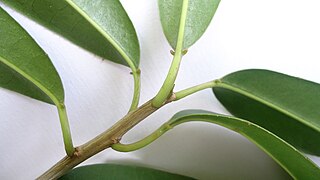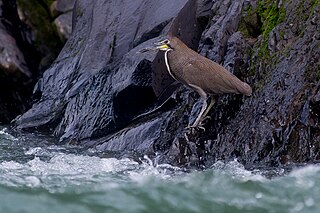
Gymnolaemata are a class of Bryozoans. Gymnolaemata are sessile, mostly marine organisms and grow on the surfaces of rocks, kelp, and in some cases on animals, like fish. Zooids are cylindrical or flattened. The lophophore is protruded by action of muscles pulling on the frontal wall. This order includes the majority of living bryozoan species.

The Integrated Taxonomic Information System (ITIS) is an American partnership of federal agencies designed to provide consistent and reliable information on the taxonomy of biological species. ITIS was originally formed in 1996 as an interagency group within the US federal government, involving several US federal agencies, and has now become an international body, with Canadian and Mexican government agencies participating. The database draws from a large community of taxonomic experts. Primary content staff are housed at the Smithsonian National Museum of Natural History and IT services are provided by a US Geological Survey facility in Denver. The primary focus of ITIS is North American species, but many biological groups exist worldwide and ITIS collaborates with other agencies to increase its global coverage.

Sapium is a genus of flowering plants in the family Euphorbiaceae. It is widespread across most of Latin America and the West Indies. Many Old World species were formerly included in the genus, but recent authors have redistributed all the Old World species into other genera.

Gatun Lake is a freshwater artificial lake to the south of Colón, Panama. At approximately 26 m (85 ft) above sea level, it forms a major part of the Panama Canal, carrying ships 33 km (21 mi) of their transit across the Isthmus of Panama. It was created June 27, 1913 when the gates of the spillway at Gatun Dam were closed. The water level was about 14.6 m (48 ft) above sea level and was expected to fill to operating levels in the next six months.

Elassoma is a genus of freshwater fish, the only member of subfamily Elassomatinae of the sunfish family Centrarchidae in the order Perciformes. It is sometimes classified as a separate family, the Elassomatidae, in a monotypic suborder, Elassomatoidei, in Perciformes. The type species is E. zonatum, the banded pygmy sunfish. The Elassomatinae are known collectively as pygmy sunfishes, but are considered by some authorities not to be true sunfishes, which are members of family Centrarchidae. Some researchers believe they are related to sticklebacks and pipefishes rather than Perciformes, though genetic research strongly implies a close relationship with the centrarchids. Currently the Integrated Taxonomic Information System classifies them in the family Elassomatidae rather than Centrarchidae.

Eoacanthocephala is a class of parasitic worms, within the phylum Acanthocephala. They feed on any aquatic cold-blooded creature such as turtles and fish. Their proboscis spines are arranged radially, with no protonephridia, and with persistent ligament sacs in female. The only reliable way to identify the group is that they only have one cement gland. This is a primitive characteristic and hence the name. The class contains 2 orders:

The Panama ghost catshark is a lesser known catshark of the family Scyliorhinidae. This catshark is only found off Panama, between 9°N and 2°N. The reproduction of the Panama ghost shark is oviparous.

The Hypostominae are a subfamily of catfishes of the family Loricariidae. Most members are restricted to tropical and subtropical South America, but there are also several species in southern Central America. Hypostomus plecostomus, which is popular in the aquarium trade, has been introduced to several regions far from its native range.

The fasciated tiger heron is a species of heron in the family Ardeidae. It is present in southern Central America and parts of northern and central South America, where its natural habitat is rivers.
Carlana is a genus of freshwater fish in the family Characidae. It contains the single species Carlana eigenmanni, which is found in Costa Rica, Nicaragua and Panama. The maximum standard length is 5.4 centimetres (2.1 in).
Leptoancistrus is a genus of armored catfishes native to Colombia and Panama.

The white sucker is a species of freshwater cypriniform fish inhabiting the upper Midwest and Northeast in North America, but it is also found as far south as Georgia and as far west as New Mexico. The fish is commonly known as a "sucker" due to its fleshy, papillose lips that suck up organic matter and aufwuchs from the bottom of rivers and streams.
Catalog of Fishes is a comprehensive on-line database and reference work on the scientific names of fish species and genera. It is global in its scope and is hosted by the California Academy of Sciences. It has been compiled and is continuously updated by the curator emeritus of the CAS fish collection, William N. Eschmeyer.

Canthigaster punctatissima, known as the spotted sharpnose puffer or the spotted sharpnosed puffer, is a species of pufferfish in the family Tetraodontidae. It is native to the Eastern Pacific, where it ranges from Guaymas, Mexico to Panama and the Galápagos Islands. It is replaced by its close relatives C. janthinoptera and C. jactator in the Western Pacific and the Hawaiian Islands, respectively. It is found in sheltered areas of rocky reefs at a depth range of 3 to 21 m and reaches 9 cm in total length. The species is reported to be monogamous.
Torquigener marleyi is a species of pufferfish in the family Tetraodontidae. It is a marine species known only from South Africa, where it occurs near the Tugela River in KwaZulu-Natal. FishBase lists this species as a synonym of Torquigener balteus, although ITIS and WoRMS list it as a valid species.

Iguanodectidae is a family of freshwater fish in the order Characiformes that lives in South America. It is home to the subfamily Iguanodectinae and the monotypic Bryconops clade. Several species in the family, such as the green line lizard tetra, the tailspot tetra, and the orangefin tetra, are sometimes taken as aquarium fish.
Hypostomus aspidolepis is a species of catfish in the family Loricariidae that is of disputed taxonomic identity. It is a freshwater fish native to Central America, where it occurs in the Gatún River basin in the Caribbean coastal drainage of Panama. The species reaches 40 cm in standard length and is believed to be a facultative air-breather. Although originally described as a member of Chaetostomus by Albert Günther in 1867, it has subsequently been classified within Hypostomus, the now-invalid genus Plecostomus, and Hemiancistrus. A 2015 review conducted by Jonathan W. Armbruster, David C. Werneke, and Milton Tan recognized the species within Hypostomus, although sources such as FishBase, WoRMS and ITIS still consider it a member of Hemiancistrus.
Leptoancistrus cordobensis is a species of catfish in the family Loricariidae. It is native to South America, where it occurs in the upper Sinú River basin as well as the upper San Jorge River basin in the Magdalena River drainage in Colombia. The species reaches 3.7 cm in standard length.
Spatuloricaria fimbriata is a species of catfish in the family Loricariidae. It is native to Central America and South America, where it occurs in the basins of the Tuira River and the Magdalena River in Panama and Colombia. The species reaches 8.4 cm in standard length.











